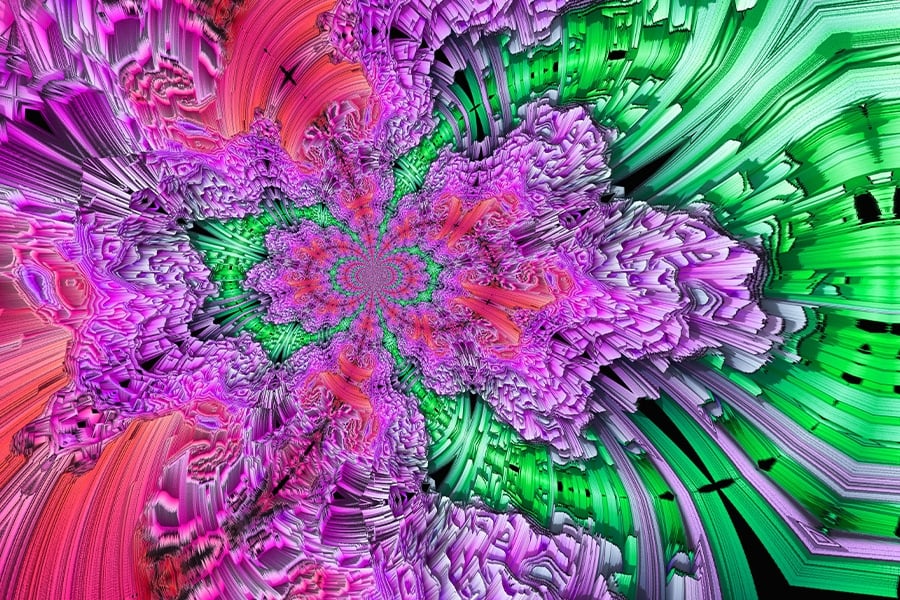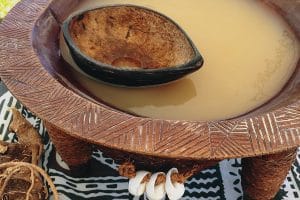In May 2019, when the Oakland City Council voted unanimously to decriminalize four species of psychoactive plants and fungi, a new and unexpected word entered the lexicon of American jurisprudence: entheogen.
The resolution listed specific entheogenic plants and fungi: the peyote and san pedro cacti, the vine and shrub used to make ayahuasca, psilocybin mushrooms, and the root bark of the iboga shrub. As the movement to decriminalize these entheogenic plants and fungi expands across the US, resolutions like those that passed in Oakland or Santa Cruz, led by a group called Decriminalize Nature, are introducing this word to an ever-widening audience.
Entheogen Definition: What Is it?
So what are entheogens exactly? If you ask someone familiar with the term, you’re likely to hear something like, “Entheogens are drugs/plants/medicine that give you a spiritual experience.” The word literally means “creating the divine within,” and is derived from the Greek roots en (within) theo (divine) and gen (creates).
An expanded definition presented in the official documents provided to the Oakland City Council explained that entheogens have been used by indigenous peoples for millennia for “healing, knowledge, creativity, and spiritual connection.” Scientific research in the last decade has also demonstrated that these entheogenic plants and fungi can treat a range of chronic illnesses: psilocybin (the active compound in shrooms) for depression, ayahuasca for grief, and so on. Decriminalizing their possession, the documents argue, “empowers Oakland residents to be able to grow their own entheogens, share them with their community, and choose the appropriate setting for their intentions.”
The word itself expresses ideas about who uses these substances, and how and why they do so, and represents an important departure from common assumptions. Communally shared, personally grown, used for spiritual and restorative purposes, these are not the “drugs” of wayward teenagers or the escapism of dropped-out hippies.
Entheogens vs. Psychedelics
Entheogen carries a web of associations that distinguish it from psychedelic in meaningful ways. Its use in the decriminalization movement reflects a marked shift in how we understand the entheogenic plants, fungi, and synthetic compounds more commonly known as psychedelics. A look at the word’s history provides a glimpse into why these distinctions matter.
How to Grow Shrooms Bundle
Take Both of Our Courses and Save $90!
The term entheogen was coined in a short academic paper in 1979 in The Journal of Psychedelic Drugs, titled simply “Entheogens.” It was written by a mix of academic and independent scholars, including an ethnobotanist, a mycologist, an ethnomycologist, and two classicists. Three of these authors were operating outside academic institutions: One, R. Gordon Wasson—the retired banker famous for first publicizing psilocybin mushrooms outside of the Sierra Mazateca—was entirely self-taught. The other two, Jonathan Ott and Jeremy Bigwood, had studied under the mycologist Michael Beug at Evergreen State University in the mid 1970s but never pursued advanced degrees. By 1978, Ott had already published three field guides to hallucinogenic plants and mushrooms in North America. This outsiderness allowed them free-reign to explore topics that were deemed immoderate, unconventional, or misguided by those in academia.
It’s not entirely unusual for amateurs to make significant contributions to field sciences like botany or mycology. However, it was unusual for their botanical research to encompass sweeping historical topics like the origin of religion. The two classicists, Carl Ruck and Danny Staples (both affiliated with Boston University at the time), specialized in ancient myth and shared this preoccupation.
In that vein, the paper opens with a brief history of modern confusion over this “unique class of drugs.” “Words are manufactured and in their making, they betray the incomprehension or prejudice of the times,” the authors wrote. What should these chemicals that alter perception, cause visions, and seem to induce temporary insanity be called? All the current names were deficient, they declared. Hallucinogen implied visual deception and delirium, a value judgment on perception and reality. Psychotomimetic, a term used by psychologists, meant literally a drug that induces psychosis; this was dismissed for obvious reasons.
What should these chemicals that alter perception, cause visions, and seem to induce temporary insanity be called?
As for psychedelic, they argued that the word suffered from a linguistic kinship with “the psycho-words” like psyche and psychology, creating an association with illness and pathology. The word was coined by psychiatrist Humphry Osmond in the 1950s in correspondence with writer Aldous Huxley, who was trying to make sense of his experiences with mescaline. It means something like “mind-manifesting” or “mind-revealing,” which sounds neutral, if not positive, relative to these other terms. The word was popularized by Timothy Leary, Ralph Metzner, and Ram Dass, first as academics and later as divisive public figures. All of this was glossed tersely by the authors who note, as further reason for its rejection, that the word had become tainted by “connotations of the pop-culture of the 1960s.”
In short, a new word was needed.
Psychedelics Rebranded as “Entheogenic Plants”
These scholars faced a peculiar problem. They needed a new word that could restore the value and perceived validity of substances that had been dismissed and denigrated by society at large. They needed a new word that would reframe the topic and make it amenable to the history and meaning they were trying to give it.
Entheogen was essentially a rebranding of psychedelic. In the original paper, the word was meant to refer to mind-altering and vision-producing substances that had been used historically to induce “states of shamanic and ecstatic possession.” Specifically, they needed a word to describe the kind of ceremonial intoxication that was essential to the authors’ own theories that ancient religion began with the consumption of psychoactive plants or fungi. This theory spun out to encompass virtually any tradition with a history of divination, prophecy, and revelation.
Specifically, they needed a word to describe the kind of ceremonial intoxication that was essential to the authors’ own theories that ancient religion began with the consumption of psychoactive plants or fungi.
But the word didn’t really take off, at least not immediately. It lingered in obscure subcultures and offshoots of the new age movement for most of the 1980s. It was only with the rise of rave and psytrance cultures of the 1990s, and the proliferation of ayahuasca tourism in the 2000s and 2010s, that it began to gain wide purchase. Today, the word circulates among a wide range of people, from ayahuasqueros with multigenerational lineage, to Burners and new age festival-goers who see their day-long parties as modern forms of ecstatic ritual.
The use of the term entheogen places contemporary party cultures in the same lineage as prehistoric divination and healing traditions. Unlike psychedelics, that looked forward towards the Age of Aquarius, entheogens look to the past.
When Someone Says Entheogenic, They Might Mean “Spiritual Drugs“
Forty years after its inception, it seems safe to assume that the word has not found its way into many government documents. Larry Norris, co-founder and board member of the sponsoring organization Decriminalize Nature, explained why they preferred entheogen to other words. The reasoning sounded very familiar. “Psychedelics,” he told me, “are related to the 60s, to the counterculture movement. Entheogens are related to practices that have been around for millennia.” Decriminalize Nature asserts that entheogens facilitate a spiritual connection with nature that is both ancient and universal. Their use of the term suggests a hope that this quality of rootedness—in nature and in history—is something that people from diverse backgrounds can relate to. Unlike psychedelics, a term for a class of drugs long associated with the white middle-class, the use of entheogens is framed primarily as a reclamation of pre-colonial practices and indigenous knowledge. Entheogens are ancient spiritual medicine that bridge indigenous cultures and modern science.
Unlike psychedelics, that looked forward towards the Age of Aquarius, entheogens look to the past.
Of course, for some, the word elicits ambivalence. In his popular book on psychedelic therapy, Michael Pollan found entheogen too burdened by religious associations. Chemist Sasha Shulgin, the “godfather of MDMA,” wrote in 2005 that he favored psychedelic over entheogen because “at least [people] know what I am talking about.” There’s also a critique that the word goes too far in the other direction, implicitly delegitimizing recreational use—that is, by healthy people, for fun. If entheogens “create God within,” is it disrespectful, even a kind of profanation, to use them for trivial pleasures? The inherent morality of the term can rub people the wrong way. And then there’s the conceptual coupling of entheogen with an idea of naturalness that implicitly excludes man-made drugs like MDMA and ketamine—drugs that can produce powerful experiences of transcendence and divinity. It’s worth noting that this coupling is contemporary. The original paper explicitly made room for synthetic substances as entheogens “in a looser sense” in that their effects were similar to traditional ritual use. We can only assume they were thinking of LSD, whose ecstatic potential was, at that point, undeniable.
From its inception, entheogen was anchored to this idea of ceremonial and religious use, as opposed to recreational. Regardless of the authors’ inclusive gestures, the term is interwoven with visions of a past where people communed with the divine through relationships with the natural world, like those with entheogenic plants and fungi. This vision—often fused with a kind of prelapsarian ideal of living in harmony with nature—has become implicit in the word, as its creators intended.
Whether or not those theories are accurate, one thing is clear: The word entheogen articulates the immense spiritual and political meaning that countless people find in these plants, fungi, and chemical compounds today. Words are manufactured and in their making, they reveal the hopes and dreams of their time.

DoubleBlind is a trusted resource for news, evidence-based education, and reporting on psychedelics. We work with leading medical professionals, scientific researchers, journalists, mycologists, indigenous stewards, and cultural pioneers. Read about our editorial policy and fact-checking process here.

DoubleBlind Magazine does not encourage or condone any illegal activities, including but not limited to the use of illegal substances. We do not provide mental health, clinical, or medical services. We are not a substitute for medical, psychological, or psychiatric diagnosis, treatment, or advice. If you are in a crisis or if you or any other person may be in danger or experiencing a mental health emergency, immediately call 911 or your local emergency resources. If you are considering suicide, please call 988 to connect with the National Suicide Prevention Lifeline.



